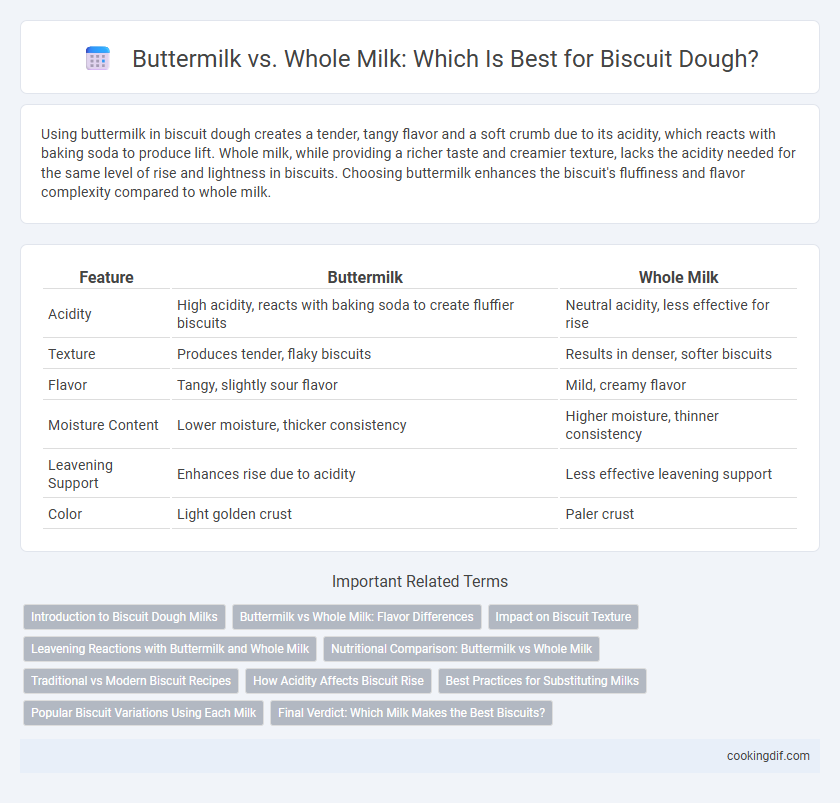Using buttermilk in biscuit dough creates a tender, tangy flavor and a soft crumb due to its acidity, which reacts with baking soda to produce lift. Whole milk, while providing a richer taste and creamier texture, lacks the acidity needed for the same level of rise and lightness in biscuits. Choosing buttermilk enhances the biscuit's fluffiness and flavor complexity compared to whole milk.
Table of Comparison
| Feature | Buttermilk | Whole Milk |
|---|---|---|
| Acidity | High acidity, reacts with baking soda to create fluffier biscuits | Neutral acidity, less effective for rise |
| Texture | Produces tender, flaky biscuits | Results in denser, softer biscuits |
| Flavor | Tangy, slightly sour flavor | Mild, creamy flavor |
| Moisture Content | Lower moisture, thicker consistency | Higher moisture, thinner consistency |
| Leavening Support | Enhances rise due to acidity | Less effective leavening support |
| Color | Light golden crust | Paler crust |
Introduction to Biscuit Dough Milks
Buttermilk and whole milk are key liquids in biscuit dough, each impacting texture and flavor uniquely. Buttermilk's acidic properties react with baking soda, producing a lighter, fluffier biscuit with a tangy taste, while whole milk contributes to a richer, denser crumb and milder flavor. Selecting the right milk depends on desired biscuit characteristics, with buttermilk favored for traditional, tender biscuits and whole milk for a heartier, buttery result.
Buttermilk vs Whole Milk: Flavor Differences
Buttermilk imparts a tangy, slightly acidic flavor to biscuit dough, enhancing the overall taste with a subtle richness and depth. Whole milk offers a milder, creamier flavor, resulting in a softer, more neutral biscuit profile. The acidity in buttermilk also reacts with baking soda, creating fluffier, more tender biscuits compared to those made with whole milk.
Impact on Biscuit Texture
Buttermilk creates a tender, moist biscuit texture due to its acidity, which reacts with baking soda to produce carbon dioxide, resulting in a light and fluffy crumb. Whole milk yields a richer, slightly denser biscuit with a finer crumb, as it lacks the acidity necessary for significant leavening reaction. Choosing buttermilk over whole milk enhances biscuit rise and imparts a subtle tang, contributing to a soft yet airy texture.
Leavening Reactions with Buttermilk and Whole Milk
Buttermilk's acidity reacts with baking soda in biscuit dough, producing carbon dioxide that creates light, fluffy textures through effective leavening reactions. Whole milk lacks this acidity, relying solely on baking powder or other leavening agents for rise, often resulting in denser biscuits. The buttermilk's acidic environment enhances gluten development control, contributing to tender, well-risen biscuits compared to those made with whole milk.
Nutritional Comparison: Buttermilk vs Whole Milk
Buttermilk contains fewer calories and less fat compared to whole milk, making it a lower-fat option for biscuit dough. It is richer in protein and provides beneficial probiotics that support digestion, unlike whole milk which lacks these live cultures. Additionally, buttermilk's acidity improves biscuit texture by reacting with baking soda to create tender, fluffy biscuits.
Traditional vs Modern Biscuit Recipes
Buttermilk is preferred in traditional biscuit recipes for its acidity, which reacts with baking soda to create tender, flaky layers. Modern biscuit recipes often use whole milk to yield a softer, less tangy texture, appealing to contemporary tastes. The choice between buttermilk and whole milk significantly impacts biscuit crumb structure and flavor, defining the classic versus modern culinary experience.
How Acidity Affects Biscuit Rise
Buttermilk's higher acidity activates baking soda more effectively than whole milk, producing carbon dioxide that helps biscuits rise fluffier and taller. The acidic environment in buttermilk also strengthens gluten bonds less aggressively, resulting in a tender, flaky texture. Whole milk lacks this acidity, causing biscuits to rise less and have a denser crumb.
Best Practices for Substituting Milks
Using buttermilk in biscuit dough enhances tenderness and adds a slightly tangy flavor due to its acidity, which reacts with baking soda for better rise. Whole milk provides a milder taste and softer texture but lacks the leavening boost from acidity, so adding a teaspoon of lemon juice or vinegar per cup can mimic buttermilk's effect. When substituting, maintain the same liquid volume and adjust leavening agents accordingly to achieve the desired biscuit texture and rise.
Popular Biscuit Variations Using Each Milk
Buttermilk biscuits offer a tangy flavor and tender crumb due to the acidic reaction with baking soda, making them popular in Southern buttermilk biscuits and flaky drop biscuits. Whole milk biscuits produce a milder taste and softer texture ideal for classic buttermilk-style buttermilk substitute biscuits and butter-rich tear-apart biscuits. Both milks bring unique moisture and richness, with buttermilk favored for traditional Southern recipes and whole milk preferred in sweeter or less tangy biscuit variations.
Final Verdict: Which Milk Makes the Best Biscuits?
Buttermilk produces the best biscuits due to its acidity reacting with baking soda, creating a tender texture and slight tangy flavor that enhances the overall taste. Whole milk yields softer, less flaky biscuits with a milder taste but lacks the depth buttermilk provides. For flaky, flavorful biscuits, buttermilk remains the preferred choice in biscuit dough recipes.
Buttermilk vs whole milk for biscuit dough Infographic

 cookingdif.com
cookingdif.com